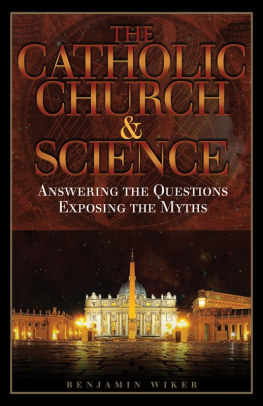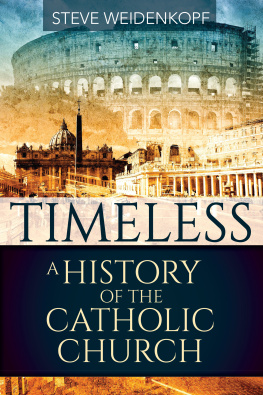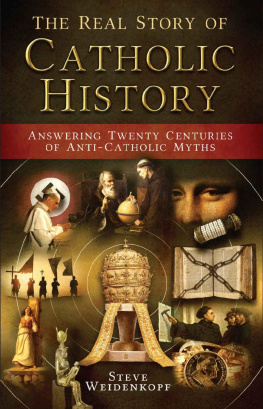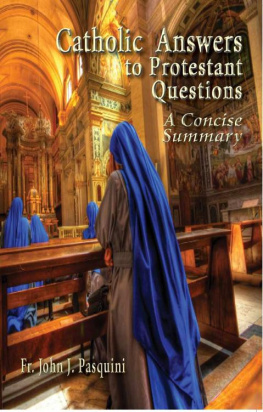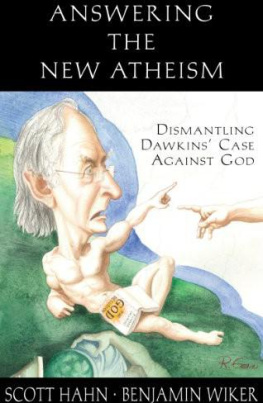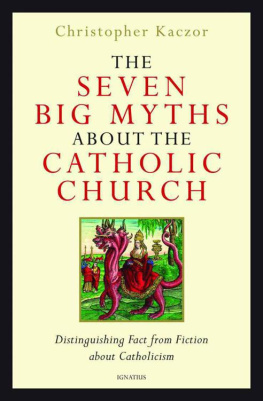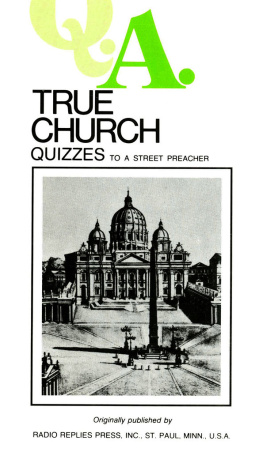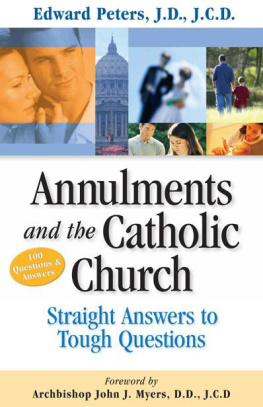Benjamin Wiker - The Catholic Church & Science: Answering the Questions, Exposing the Myths
Here you can read online Benjamin Wiker - The Catholic Church & Science: Answering the Questions, Exposing the Myths full text of the book (entire story) in english for free. Download pdf and epub, get meaning, cover and reviews about this ebook. year: 2011, publisher: TAN Books, genre: Religion. Description of the work, (preface) as well as reviews are available. Best literature library LitArk.com created for fans of good reading and offers a wide selection of genres:
Romance novel
Science fiction
Adventure
Detective
Science
History
Home and family
Prose
Art
Politics
Computer
Non-fiction
Religion
Business
Children
Humor
Choose a favorite category and find really read worthwhile books. Enjoy immersion in the world of imagination, feel the emotions of the characters or learn something new for yourself, make an fascinating discovery.
- Book:The Catholic Church & Science: Answering the Questions, Exposing the Myths
- Author:
- Publisher:TAN Books
- Genre:
- Year:2011
- Rating:5 / 5
- Favourites:Add to favourites
- Your mark:
- 100
- 1
- 2
- 3
- 4
- 5
The Catholic Church & Science: Answering the Questions, Exposing the Myths: summary, description and annotation
We offer to read an annotation, description, summary or preface (depends on what the author of the book "The Catholic Church & Science: Answering the Questions, Exposing the Myths" wrote himself). If you haven't found the necessary information about the book — write in the comments, we will try to find it.
The Catholic Church & Science: Answering the Questions, Exposing the Myths — read online for free the complete book (whole text) full work
Below is the text of the book, divided by pages. System saving the place of the last page read, allows you to conveniently read the book "The Catholic Church & Science: Answering the Questions, Exposing the Myths" online for free, without having to search again every time where you left off. Put a bookmark, and you can go to the page where you finished reading at any time.
Font size:
Interval:
Bookmark:
The Catholic Church and Science
Answering the Questions, Exposing the Myths
Benjamin Wiker
TAN Books
Charlotte, North Carolina
2011 Benjamin Wiker
All rights reserved. With the exception of short excerpts used in articles and critical reviews, no part of this work may be reproduced, transmitted, or stored in any form whatsoever, printed or electronic, without the prior written permission of the publisher.
ISBN: 978-0-89555-943-2
Cover design by Tony Pro.
Contents
Introduction
G. K. Chesterton once famously described the Church as a carefully balanced chariot careening through history:
People have fallen into a foolish habit of speaking of orthodoxy as something heavy, humdrum, and safe. There never was anything so perilous or so exciting as orthodoxy. It was sanity: and to be sane is more dramatic than to be mad. It was the equilibrium of a man behind madly rushing horses, seeming to stoop this way and to sway that, yet in every attitude having the grace of statuary and the accuracy of arithmetic. The Church in its early days went fierce and fast with any warhorse She swerved to the left and right, so exactly as to avoid enormous obstacles. She left on one hand the huge bulk of Arianism, buttressed by all the worldly powers to make Christianity too worldly. The next instant she was swerving to avoid an orientalism, which would have made it too unworldly. The orthodox Church never took the tame course or accepted the conventions; the orthodox Church was never respectable. It would have been easier to have accepted the Earthly power of the Arians. It would have been easy, in the Calvinistic seventeenth century, to fall into the bottomless pit of predestination. It is always easy to let the age have its head; the difficult thing is to keep ones own. It is always easy to be a modernist; as it is easy to be a snob. To have fallen into any of those open traps of error and exaggeration which fashion after fashion and sect after sect set along the historic path of Christendomthat would indeed have been simple. It is always simple to fall; there are an infinity of angles at which one falls, only one at which one stands. To have fallen into any one of the fads from Gnosticism to Christian Science would indeed have been obvious and tame. But to have avoided them all has been one whirling adventure; and in my vision the heavenly chariot flies thundering through the ages, the dull heresies sprawling and prostrate, the wild truth reeling but erect.
I dont expect to be understood, at this early point in the book, when I say that Chesterton has here captured, in some important senses, the truth about the relationship of the Catholic Church to science. It may seem a startling suggestion, because we dont think of science as somehow partaking of the strange vagaries and varieties of fashion and sect that one finds in the history of Christianity or the history of philosophy. And we certainly dont think of the Church as a charioteer swinging madly, left and right, to avoid scientific heresies. Unlike Chestertons heavenly chariot, which lurches and reels through history, science, we are told, is a stately and stable omnibus taking humanity on a straight path from darkness to light, from superstition and ignorance to truth. Whereas the Church, we are also told, is something like a bedraggled old man on a donkeyat first clumsily and stupidly getting in the way of the omnibus of science, and then, once it has sped past, clumping sulkily behind.
Against all expectations, then, I will be making the case that Chestertons vision of the Church as a chariot swerving to avoid errors to the left and right is also an entirely appropriate image of the Catholic Churchs relationship to science. The difference is that whereas in regard to doctrinal orthodoxy the Church is immediately concerned with weeding out truth from heresy, in regard to science it is mediately concerned with weeding out falsehood from truth.
To avoid a misunderstanding here, I state plainly that the Church does not dictate the substance and detail of the various sciences. But for that matter, neither do the scientists. The particular reality under consideration determines the substance and details of each science, and thence judges the truth or falsehood of human scientific conjectures. The entomologist is not in the seat of ultimate authority; rather, the insects themselves have the last say in sorting out truth from falsehood in the entomologists theories. The stars themselves will declare which astronomers are orthodox and which are heretics. The Earth has ultimate say against any geologist, no matter how prestigious. Nature itself, in all its profound complexity and mystery, is the ultimate authority over scientists.
But if the Church does not dictate the substance or the detail of any of the sciences, it watches with great care the proper parameters of the sciences and the general (and sometimes particular and peculiar) assumptions of the scientists. Here it must judge, and the reason is both simple and profound. Scientists are human, and sometimes the Church must step in to remind them of their limits, especially those limits that safeguard their own humanity (just as, in regard to Christian orthodoxy, the Church stepped in to safeguard both Christs divinity and His humanity).
Lets take an important case to make the point more clear. As Chesterton noted, the Church intervened against John Calvins doctrine of predestination. Calvin was so enamored of Gods omniscience and omnipotence that he asserted that God created human beings already having determined who would be damned. Since ones eternal destiny in Heaven or Hell was thus laid out before one even existed, there wasnt anything that could be done to change it. Ones actions were therefore of no (eternal) consequence. If this were true, the result would be both the ruin of our everyday experience of choosing to do or not do good and evil actions, and the casting away of the entire corpus of New Testament admonitions by Jesus Christ to do certain things in order to gain eternal life and to not do certain things in order to avoid eternal damnation. Calvinistic predestination made a hash of human action, both in regard to our experience of natural, everyday life, and in regard to revealed, supernatural truths about the relationship of our actions to our eternal destiny. The Church, even while mightily affirming Gods omniscience and omnipotence, swerved away from Calvin and went hurtling onward.
But in modernity, a new kind of natural doctrine of predestination arose, championed by the scientific and philosophical materialists: those who argued that all of reality could be reduced to bits or clumps of inanimate matter, generally called atoms. The materialists denied the existence of the soul and proclaimed that all matter was subject to eternal laws that determined all motion. Our common, everyday experience of freely choosing our actions was illusory, for even our choosing was the result of the microscopic internal atomic motion of our bodies that was, as all things material, predestined by the laws of nature.
This heresy is still with us. It denies our experience of choosing, of having free will, and therefore, exactly like Calvins heresy, makes hash of human action and nonsense of morality. And so the Church has swerved away from this scientific heresy, which is still in fashion even after 500 years, and condemned materialism and determinism, even while heartily affirming the study of the wonders of nature in astronomy, physics, chemistry, and biology.
Likewise, the Church has always rejected pantheismalso popular in modernity, especially among philosophers and physicistswherein God is collapsed into nature and nature into God. The Church has done so for the doctrinal reason that Scripture reveals in Genesis, quite clearly, that God and nature are entirely distinct as Creator and creation, and also for the obvious natural reason that the Earth and the stars arent gods (no matter what ancient or modern pagans dream to the contrary).
Next pageFont size:
Interval:
Bookmark:
Similar books «The Catholic Church & Science: Answering the Questions, Exposing the Myths»
Look at similar books to The Catholic Church & Science: Answering the Questions, Exposing the Myths. We have selected literature similar in name and meaning in the hope of providing readers with more options to find new, interesting, not yet read works.
Discussion, reviews of the book The Catholic Church & Science: Answering the Questions, Exposing the Myths and just readers' own opinions. Leave your comments, write what you think about the work, its meaning or the main characters. Specify what exactly you liked and what you didn't like, and why you think so.

